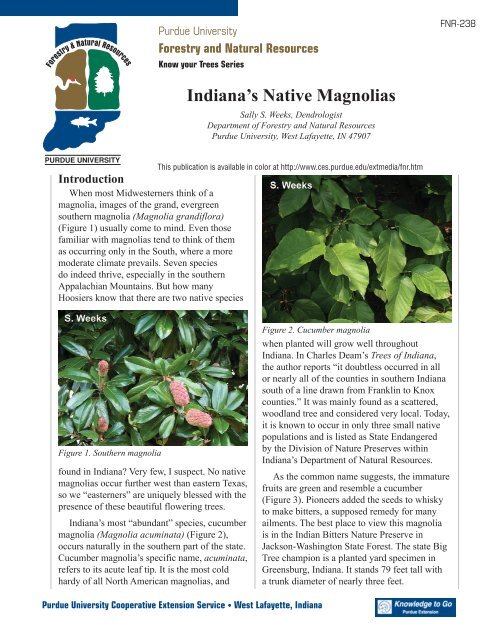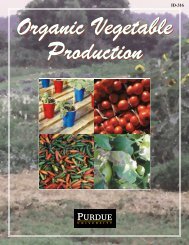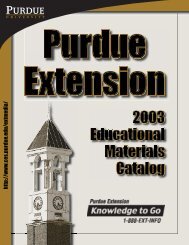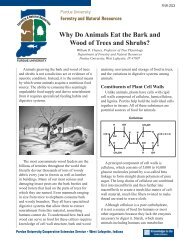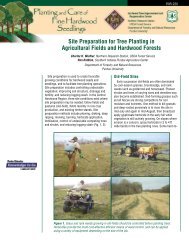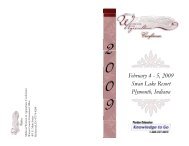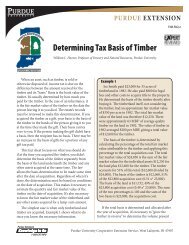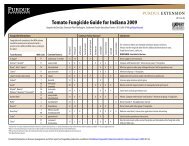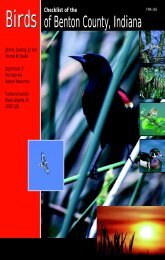Indiana's Native Magnolias - Purdue Extension - Purdue University
Indiana's Native Magnolias - Purdue Extension - Purdue University
Indiana's Native Magnolias - Purdue Extension - Purdue University
You also want an ePaper? Increase the reach of your titles
YUMPU automatically turns print PDFs into web optimized ePapers that Google loves.
<strong>Purdue</strong> <strong>University</strong><br />
Forestry and Natural Resources<br />
Know your Trees Series<br />
Indiana’s <strong>Native</strong> <strong>Magnolias</strong><br />
Sally S. Weeks, Dendrologist<br />
Department of Forestry and Natural Resources<br />
<strong>Purdue</strong> <strong>University</strong>, West Lafayette, IN 47907<br />
This publication is available in color at http://www.ces.purdue.edu/extmedia/fnr.htm<br />
Introduction<br />
When most Midwesterners think of a<br />
magnolia, images of the grand, evergreen<br />
southern magnolia (Magnolia grandiflora)<br />
(Figure 1) usually come to mind. Even those<br />
familiar with magnolias tend to think of them<br />
as occurring only in the South, where a more<br />
moderate climate prevails. Seven species<br />
do indeed thrive, especially in the southern<br />
Appalachian Mountains. But how many<br />
Hoosiers know that there are two native species<br />
Figure 1. Southern magnolia<br />
found in Indiana? Very few, I suspect. No native<br />
magnolias occur further west than eastern Texas,<br />
so we “easterners” are uniquely blessed with the<br />
presence of these beautiful flowering trees.<br />
Indiana’s most “abundant” species, cucumber<br />
magnolia (Magnolia acuminata) (Figure 2),<br />
occurs naturally in the southern part of the state.<br />
Cucumber magnolia’s specific name, acuminata,<br />
refers to its acute leaf tip. It is the most cold<br />
hardy of all North American magnolias, and<br />
Figure 2. Cucumber magnolia<br />
<strong>Purdue</strong> <strong>University</strong> Cooperative <strong>Extension</strong> Service • West Lafayette, Indiana<br />
when planted will grow well throughout<br />
Indiana. In Charles Deam’s Trees of Indiana,<br />
the author reports “it doubtless occurred in all<br />
or nearly all of the counties in southern Indiana<br />
south of a line drawn from Franklin to Knox<br />
counties.” It was mainly found as a scattered,<br />
woodland tree and considered very local. Today,<br />
it is known to occur in only three small native<br />
populations and is listed as State Endangered<br />
by the Division of Nature Preserves within<br />
Indiana’s Department of Natural Resources.<br />
As the common name suggests, the immature<br />
fruits are green and resemble a cucumber<br />
(Figure 3). Pioneers added the seeds to whisky<br />
to make bitters, a supposed remedy for many<br />
ailments. The best place to view this magnolia<br />
is in the Indian Bitters Nature Preserve in<br />
Jackson-Washington State Forest. The state Big<br />
Tree champion is a planted yard specimen in<br />
Greensburg, Indiana. It stands 79 feet tall with<br />
a trunk diameter of nearly three feet.<br />
FNR-238<br />
1
2<br />
Figure 3. Immature<br />
cucumber magnolia fruit<br />
Indiana’s second<br />
native species,<br />
umbrella magnolia<br />
(Magnolia tripetala)<br />
(Figure 4), has been<br />
found in one wooded<br />
ravine in Crawford<br />
County and is listed<br />
as State Endangered<br />
as well. It was not<br />
until 1945 that<br />
these few trees were<br />
distinguished from<br />
cucumber magnolias<br />
by Frank McFarland.<br />
Pioneers from that<br />
area always had mistaken it for cucumber<br />
magnolia.<br />
Figure 4. Unbrella magnolia<br />
Umbrella magnolia is a much smaller species<br />
than cucumber magnolia, especially in Indiana,<br />
and it struggles to attain a diameter of 6 inches.<br />
Open grown trees are often bushy. The common<br />
name refers to the fact that all of its long leaves<br />
are clustered at the end of the limbs, giving an<br />
umbrella-like appearance. Its specific name<br />
tripetala refers to the whorls of three petals and<br />
sepals in its flowers. Like all magnolias, this<br />
species prefers cool, wooded ravines with deep,<br />
rich, moist soils. It is the most cold hardy of<br />
the “big-leaved” magnolias, but it is sensitive<br />
to wind and ice. Currently, there is no Big Tree<br />
champion for Indiana.<br />
Identification<br />
Leaves: Leaves of both species are<br />
deciduous. Cucumber magnolia has smaller<br />
leaves (Figure 5) than umbrella, generally<br />
six to seven inches long, but they can reach<br />
Figure 5. Cucumber magnolia leaves<br />
a maximum length of ten inches. They are<br />
uniformly broad and somewhat egg-shaped with<br />
an entire margin. The leaf tip is abruptly pointed<br />
(acute), while the base is flattened or acute.<br />
Leaves are dull green and smooth above, lightly<br />
hairy and a bit more pale beneath.<br />
Umbrella magnolia is considered one of the<br />
“big-leaved” magnolias native to the eastern<br />
United States. Its leaves (Figure 6) are up to 20<br />
inches long with a shape similar to an airplane<br />
propeller blade (obovate-lanceolate). The leaf<br />
Figure 6. Umbrella magnolia leaves<br />
tip is bluntly acute and the V-shaped base narrows<br />
to the petiole. They are light green and smooth<br />
above, lightly hairy and pale beneath. One of the
first things to look for when identifying any<br />
magnolia is the shape of the leaf base. Several<br />
species that occur together in the southern<br />
Appalachian Mountains have lobed leaf bases<br />
(Figure 7 – bigleaf magnolia (M. macrophylla)),<br />
a characteristic that easily separates them from<br />
umbrella and cucumber magnolias.<br />
Figure 7. Bigleaf magnolia leaf base<br />
Buds: Buds of the two species are quite<br />
different. Cucumber magnolia buds (Figure<br />
8) are one inch long and somewhat elongated,<br />
Figure 8. Cucumber<br />
magnolia buds<br />
Figure 9. Umbrella<br />
magnolia buds<br />
especially when compared to those of the many<br />
introduced species. They are pale gray-green<br />
and densely hairy (pubescent). There are no<br />
visible scales.<br />
Umbrella magnolia buds (Figure 9) are<br />
elongate and over one inch long. They are<br />
purple green, hairless (glabrous) and often<br />
covered with a whitish bloom (glaucous). They<br />
have several visible scales.<br />
Twigs: All members of the Magnolia<br />
family share a common and rather unusual<br />
characteristic – a stipule scar that encircles<br />
the twig at each node. Stipules are leaf-like<br />
bracts that emerge in the spring with the leaves.<br />
Magnolia stipules are attached to the petiole of<br />
each leaf (Figure 10) and the twig. They can<br />
drop anytime during the growing season, and<br />
when they do, they leave behind a permanent<br />
stipule scar (Figure 11). This same scar can be<br />
seen on the twigs of tuliptree, another member<br />
of the family.<br />
Figure 10. Magnolia<br />
stipules<br />
Figure 11. Stipule scar<br />
Flowers: Flowers are the main reason<br />
people plant magnolias. From an ornamental<br />
standpoint, they can hardly be beat, and many<br />
domestic varieties on the market are selected<br />
for that key attraction. In Indiana, our native<br />
magnolias flower in early May after the leaves<br />
have developed. All magnolia flowers are<br />
terminal, and sit upright at the end of branches.<br />
Cucumber magnolia has relatively small flowers<br />
3
4<br />
Figure 12. Cucumber<br />
magnolia flower<br />
Figure 13. Umbrella<br />
magnolia flower<br />
(Figure 12), only an inch wide with petals that<br />
are two to three inches long. They have six<br />
greenish petals that are often overlooked, as<br />
they blend in well with the leaves. They are<br />
very aromatic and appear bluish green from a<br />
distance.<br />
Umbrella magnolia, unfortunately, is one of<br />
the few magnolias with malodorous (described<br />
as dirty gym socks by one author!) flowers. But<br />
never-the-less, they are showy and large, up to<br />
10 inches across and creamy-white (Figure 13).<br />
They have six to nine petals and three reflexed<br />
sepals, all seeming to be in whorls of three.<br />
The filaments are purple. Magnolia flowers are<br />
rather short-lived – within a week they begin<br />
to fade, so one must enjoy them while they are<br />
around.<br />
Fruit: <strong>Magnolias</strong> produce fruit that is<br />
technically known as an aggregate of follicles.<br />
That just means that<br />
each fruiting head<br />
is made up of many<br />
ovaries combined<br />
into one. It resembles<br />
a cone (pine cone<br />
shape). Indiana’s<br />
state tree, the tuliptree<br />
(Liriodendron<br />
tulipifera), is in<br />
the same family<br />
as the magnolias<br />
(Magnoliaceae), and<br />
if one looks carefully<br />
at its fruit (Figure 14),<br />
Figure 14. Tulip-tree fruit the resemblance in<br />
shape may be seen. Our native magnolia fruits<br />
ripen in late summer.<br />
Cucumber magnolia fruits (Figure 15) are<br />
the same size as its flower petals, two to three<br />
inches long. They sit upright on the twigs, just<br />
like the flowers. The ripe fruit is rosy-red and<br />
glabrous, with many bright red seeds, that upon<br />
emerging from the fruit, are suspended by a<br />
short, thin thread (funiculus). The fruit often<br />
looks malformed.<br />
Figure 15. Cucumber<br />
magnolia fruits<br />
Figure 16. Umbrella<br />
magnolia fruits<br />
Umbrella magnolia fruit (Figure 16) is<br />
about four inches long, rosy-red and glabrous,<br />
with bright red seeds. It looks very similar<br />
to cucumber magnolia, but tends to be more<br />
uniformly “plump.”<br />
Bark: Cucumber magnolia is the only native<br />
North American magnolia that does not have<br />
smooth, gray bark (Figure 17). It is gray-brown<br />
with narrow ridges divided by long, vertical<br />
fissures. It is similar to the bark of white ash<br />
(Fraxinus americana), but is thinner with no<br />
interlacing furrows. The tree often appears<br />
somewhat brown because pieces of the outer<br />
bark tend to sluff, exposing the darker inner<br />
bark.<br />
Umbrella magnolia, on the other hand, has<br />
typical magnolia bark (Figure 18). It is ashgray,<br />
smooth and thin. Its bark is similar to that<br />
of American beech (Fagus grandifolia) and<br />
pawpaw (Asimina triloba).
Figure 17. Cucumber<br />
magnolia bark<br />
Figure 18. Umbrella<br />
magnolia bark<br />
Form: Cucumber magnolia is certainly the<br />
largest native magnolia in the Midwest. It can<br />
grow to a height of 80 feet with a trunk diameter<br />
of four feet. Open grown trees (Figure 19) can<br />
be large and impressive, with low, sweeping<br />
branches that often almost touch the ground.<br />
The crown is large and pyramidal-shaped.<br />
Forest-grown trees have a similar growth form<br />
to its cousin, the tuliptree. They are tall, straight<br />
and limbless for many feet.<br />
Figure 19. Open grown cucumber magnolia<br />
Umbrella magnolia is a small tree, only<br />
attaining heights of 30 feet. A large tree<br />
in Indiana might have a trunk diameter of<br />
six inches and a height of 20 feet. It has an<br />
irregular, wide spreading, open crown and will<br />
grow bushy in a yard setting. Forest grown trees<br />
could be described as “spindly.”<br />
Range Maps<br />
Figure 20. Natural range of cucumber magnolia<br />
Figure 21. Natural range of umbrella magnolia<br />
Similar Species<br />
In Indiana, the tree most often mistaken<br />
for a magnolia is the very common pawpaw.<br />
Pawpaw’s leaves (Figure 22) are nearly identical<br />
to those of umbrella magnolia. One main<br />
feature, however, gives the pawpaw away: crush<br />
a leaf if in doubt – the pawpaw leaf will give<br />
5
6<br />
Figure 22. Pawpaw’s leaves and bud<br />
off an odor that has been described as similar<br />
to green peppers and diesel fuel. A close look at<br />
the pawpaw bud also distinguishes it. It is small,<br />
chocolate-brown, and shaped like a feather.<br />
Twigs have no stipular scars. The bark and form<br />
of pawpaw is very much like that of umbrella<br />
magnolia.<br />
Other magnolia species and horticultural<br />
varieties not native to the United States are<br />
commonly sold in nurseries. It is extremely<br />
rare to find a nursery selling natives,<br />
unless they specialize in them. Several<br />
magnolias commonly offered in midwestern<br />
nurseries include Star magnolia (Magnolia<br />
stellata), saucer magnolia (Magnolia x<br />
soulangiana) (Figure 23), and Magnolia<br />
Figure 23. Saucer magnolia<br />
lilliflora. They all have very similar<br />
characteristics, making identification difficult<br />
unless they are encountered when flowering.<br />
Most have dark green, rather thick leaves<br />
(Figure 24) that are about six inches long, and<br />
densely hairy buds that are about one inch in<br />
Figure 24. Introduced magnolia species<br />
length. Flowers of some species are more boldly<br />
colored than our natives.<br />
Other species native to the eastern United<br />
States may be encountered when traveling in<br />
Indiana. In the extreme southern part of the<br />
state, southern magnolia has been planted<br />
occasionally and tolerates the climate there (just<br />
barely). It is native to the coastal plain of the<br />
Southeast. Another species, sweetbay (Magnolia<br />
virginiana) (Figure 25) has begun to make an<br />
appearance in some midwestern nurseries. It<br />
Figure 25. Sweetbay<br />
magnolia leaves (top)<br />
and flower (left)
is a large tree in its native swampy habitat of<br />
the south, but a hardy, much smaller form is<br />
being marketed by horticulturists. It is easily<br />
distinguished by its smaller, leathery leaves (up<br />
to six inches long and perhaps two inches wide)<br />
with obvious whitish undersides.<br />
Propagation<br />
Fruit should be collected in the fall after the<br />
“cones” open. Individual seeds should have the<br />
fleshy outer coat removed by scraping with a<br />
fingernail in a water bath. Allow seeds to air<br />
dry for several days before storing in a ziplock<br />
bag in the refrigerator over winter. Umbrella<br />
magnolia seeds will germinate the same spring<br />
as planted. Cucumber magnolia seeds will<br />
germinate the second spring after planting. Plant<br />
seedlings in protected areas, preferably in a<br />
partially shaded location with rich, deep, moist<br />
soils. Growth is rapid once established. One<br />
word of caution about transplanting seedlings:<br />
they have very fleshy, tender roots that are<br />
sensitive to disturbance. Be gentle!<br />
Sources<br />
<strong>Native</strong> species of trees and shrubs are<br />
difficult to purchase through nurseries, but<br />
several that offer magnolias are:<br />
Ø ArborVillage, 15606 County Rd. CC, PO<br />
Box 227, Holt, MO 64048<br />
both native magnolia species sold<br />
www.arborvillage@aol.com<br />
Ø Arrowhead Alpines, PO Box 857,<br />
Fowlerville, MI 48836<br />
umbrella magnolia sold<br />
www.arrowheadalpines.com<br />
Ø Johnson’s Nursery Inc., W. 180 N. 6275<br />
Marcy Rd., Menomonee Falls, WI 53051<br />
umbrella magnolia sold<br />
www.johnsonsnursery.com<br />
Ø Mellinger’s Inc., 2310 W. South Range Rd.,<br />
North Lima, OH 44452-9731<br />
both native magnolia species sold<br />
www.mellingers.com<br />
Ø Oikos, PO Box 19425, Kalamazoo, MI<br />
49019-0425<br />
both native magnolia species sold<br />
www.oikostreecrops.com<br />
References<br />
Brown, Claud L., and L. Katherine Kirkman.<br />
1990. Trees of Georgia and Adjacent States.<br />
Timber Press, Portland, Oregon. 292pp.<br />
Deam, Charles C. 1953. Trees of Indiana.<br />
Indiana Division of Forestry, Indianapolis,<br />
Indiana. 330pp.<br />
Dirr, Michael A. 1998. Manual of Woody<br />
Landscape Plants. Stipes Publishing L.L.C.,<br />
Champaign, Illinois. 1187pp.<br />
Flint, Harrison L. 1983. Landscape Plants for<br />
Eastern North America. John Wiley and<br />
Sons, New York. 677pp.<br />
Sargent, Charles S. 1894. The Silva of North<br />
America, Vol. 1. Houghton, Mifflin and Co.,<br />
Boston. 119pp.<br />
7
8<br />
It is the policy of the <strong>Purdue</strong> <strong>University</strong> Cooperative <strong>Extension</strong> Service, David C. Petritz, Director,<br />
that all persons shall have equal opportunity and access to the programs and facilities without regard to race, color, sex, religion, national<br />
origin, age, marital status, parental status, sexual orientation, or disability.<br />
<strong>Purdue</strong> <strong>University</strong> is an Affirmative Action employer.<br />
This material may be available in alternative formats.<br />
1-888-EXT-INFO<br />
http://www.fnr.purdue.edu http://www.ces.purdue.edu/extmedia<br />
10/03


